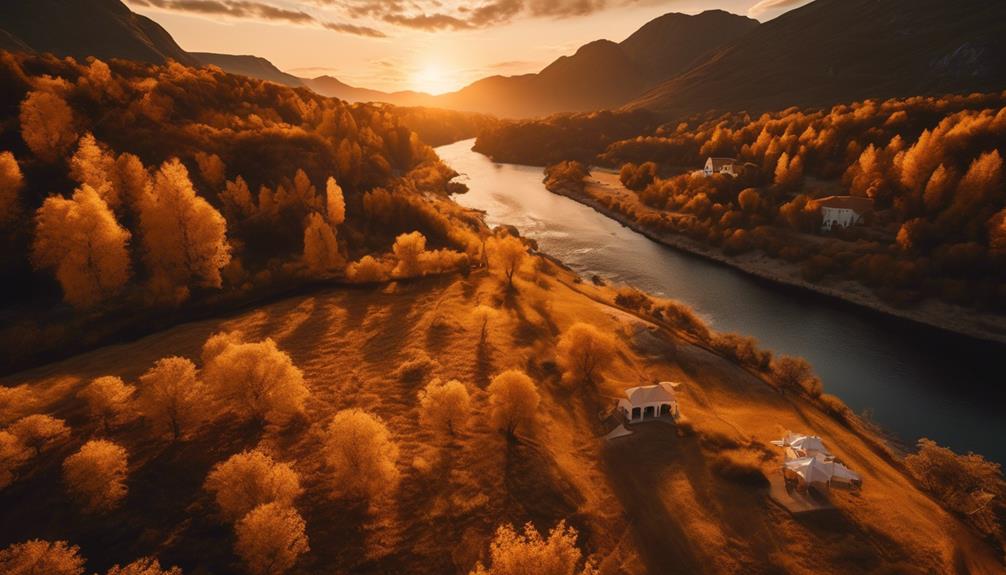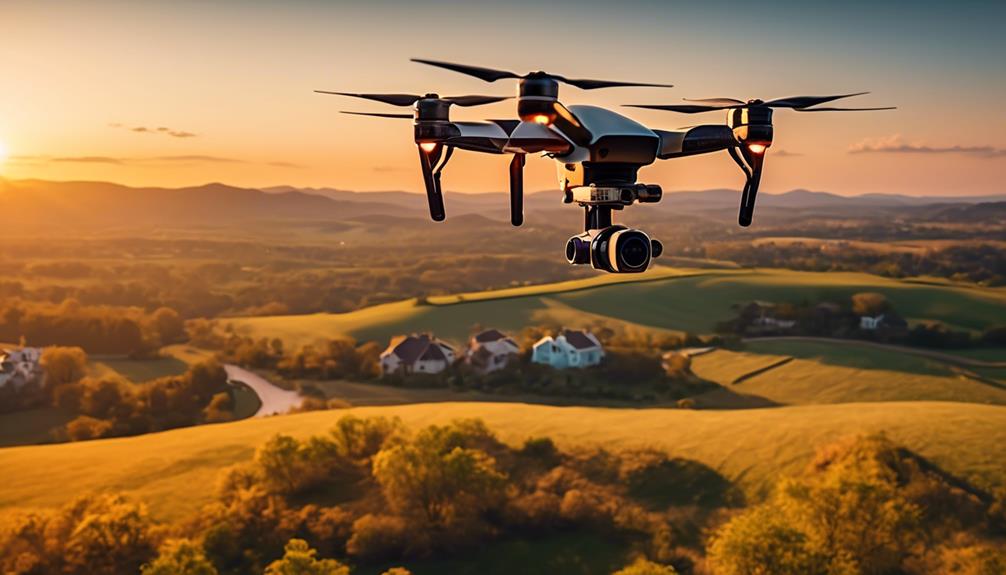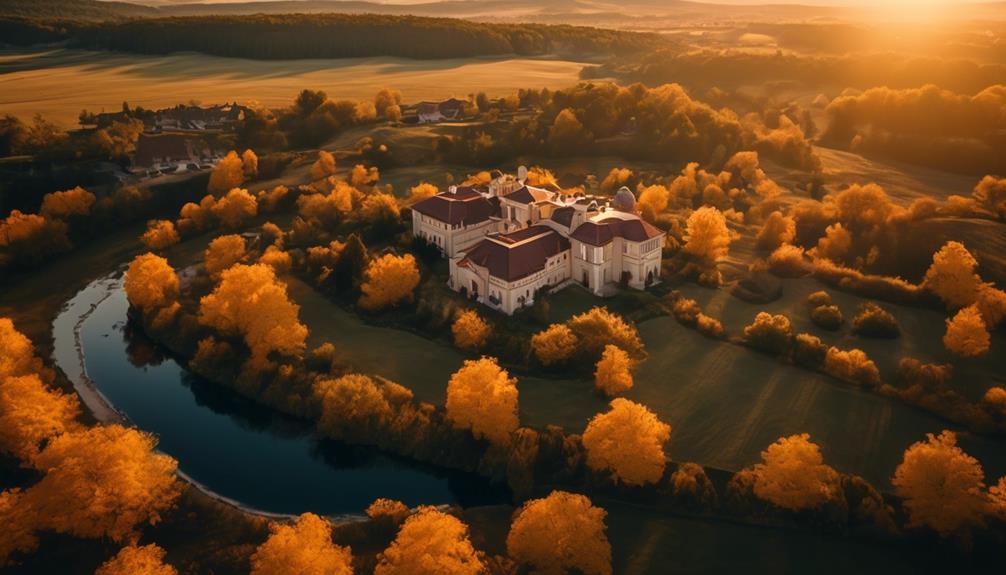Please note this post may contain affiliate links picked by me (Jay) that I have deemed may be of interest or relevant to you the reader of this.
These links do not affect the cost of the thing if you decide to purchase but i may get a little money if you choose to purchase.
For more information on my affiliate link policy click here.
As I soared high above the breathtaking landscapes, my drone capturing the world from a whole new perspective, I couldn't help but be amazed by the power of photography.
But, as a novice shutterbug, I quickly realized that capturing the perfect shot requires more than just a drone and a click of a button. It's all about the settings, the technical aspects that can elevate your photos from ordinary to extraordinary.
So, if you're ready to take your drone photography to new heights, join me as we explore the top settings that will help you unlock your creative potential and capture stunning aerial imagery.
Key Takeaways
- Proper exposure settings are crucial for enhancing the composition and visual impact of drone photographs.
- White balance adjustments ensure accurate colors in different lighting conditions and can be achieved through preset settings or custom calibration.
- ISO settings control the sensitivity of the image sensor to light and should be chosen based on the available lighting conditions to balance image quality and noise.
- Shutter speed selection allows for capturing motion freeze or motion blur effects, and should be adjusted according to the lighting and movement of the subject.
Understanding Exposure Settings
Understanding exposure settings is crucial for capturing stunning drone photographs. As a drone photographer, I've come to appreciate the impact that exposure has on the final image. It determines the brightness, contrast, and overall mood of the photo. By mastering exposure settings, you can elevate your drone photography to new heights.
One of the first things to understand is how exposure affects composition techniques. Whether you're shooting landscapes, cityscapes, or even portraits, proper exposure can enhance the visual impact of your subject. It allows you to control the balance between light and shadow, highlighting the key elements and creating a dynamic composition. Experimenting with exposure settings will help you achieve the desired effect and make your photos visually engaging.
Exploring different camera angles is another area where exposure settings play a significant role. By adjusting the exposure, you can emphasize certain features or elements in your shot. For example, by underexposing the background, you can draw attention to the subject in the foreground. Likewise, overexposing can create a dreamy, ethereal effect. By experimenting with exposure, you can add depth and visual interest to your drone photographs.
Innovation in drone photography lies in understanding how exposure settings can be used creatively. Don't be afraid to push the boundaries and experiment with different exposure values. Take advantage of the drone's freedom to explore unique angles and perspectives. By combining innovative camera angles with well-executed exposure settings, you can capture breathtaking images that will leave your audience in awe.
Mastering exposure settings is a continuous learning process, but with practice and experimentation, you'll gain a deeper understanding of how it can transform your drone photography. So, grab your drone, explore different camera angles, and unleash your creativity through exposure settings. The possibilities are endless, and the results will be nothing short of extraordinary.
Mastering White Balance
As I continue to explore the art of drone photography, I've discovered that mastering white balance is essential for achieving captivating and true-to-life images. White balance refers to the adjustment of colors in an image to ensure color accuracy, especially when shooting in different lighting conditions.
Here are some tips to help you achieve perfect white balance in your drone photography:
- Understand the different white balance settings: Most drones come with preset white balance options such as Auto, Sunny, Cloudy, and Fluorescent. Experiment with these settings to see how they affect the colors in your photos.
- Custom white balance: Some drones allow you to manually set the white balance based on the specific lighting conditions. This can be done by taking a photo of a white reference card or a neutral gray surface and using it as a reference for accurate color representation.
- Post-processing adjustments: If you aren't satisfied with the white balance in your drone photos, you can always make adjustments during post-processing. Software like Adobe Lightroom or Photoshop allows you to fine-tune the white balance to achieve the desired look.
Mastering white balance in drone photography is crucial because it ensures that the colors in your images are true to life. Whether you're shooting on a sunny day or under fluorescent lights, adjusting the white balance will help you achieve color accuracy and bring out the beauty of your subjects.
Optimizing ISO for Drone Photography
To capture stunning and noise-free drone photos, optimizing the ISO settings is essential. ISO selection plays a crucial role in determining the image quality and the amount of noise present in your photographs. The ISO setting controls the sensitivity of the camera's image sensor to light. Higher ISO settings allow you to capture images in low light conditions but can introduce noise, while lower ISO settings produce cleaner images but require more light. Finding the right balance is key to achieving the best results.
When it comes to ISO selection for drone photography, there are a few things to consider. First, assess the lighting conditions of your environment. If you're shooting in bright daylight, a lower ISO setting, such as 100 or 200, should suffice. On the other hand, if you're shooting in dimly lit areas or during sunset or sunrise, you may need to increase the ISO to maintain a fast enough shutter speed.
To help you understand the relationship between ISO, noise, and image quality, refer to the table below:
| ISO Setting | Noise Level | Image Quality |
|---|---|---|
| Low | Minimal | Excellent |
| Medium | Moderate | Good |
| High | High | Average |
To further enhance the image quality and reduce noise, consider using noise reduction techniques during post-processing. Noise reduction software can effectively minimize the unwanted grain or speckles that may appear in your images at higher ISO settings.
Choosing the Right Shutter Speed
Now that we've optimized the ISO settings for our drone photography, let's explore the important aspect of choosing the right shutter speed. The shutter speed determines how long the camera's sensor is exposed to light, and it plays a crucial role in capturing the perfect shot.
Here are some key considerations to keep in mind when selecting your shutter speed:
- Freezing Motion: When photographing fast-moving subjects, such as sports events or wildlife, a faster shutter speed is essential to freeze the action and capture every detail. Set your shutter speed to 1/1000th of a second or faster to ensure sharp and crisp images.
- Creating Motion Blur: On the other hand, if you want to convey a sense of movement or capture the flow of water or traffic, a slower shutter speed is ideal. By using a longer exposure, such as 1/30th of a second or slower, you can create a beautiful motion blur effect that adds a dynamic element to your photos.
- Adjusting for Lighting Conditions: In low light situations, you may need to decrease your shutter speed to allow more light into the camera. However, be cautious as this can also introduce camera shake. To avoid blurriness, consider using a tripod or increasing the ISO setting to maintain image sharpness.
Choosing the right shutter speed requires finding the perfect balance between freezing motion and creating motion blur. Experiment with different settings to achieve the desired effect in your drone photography. Remember, innovation is key, so don't be afraid to push the boundaries and explore new creative possibilities. With practice and experimentation, you'll soon master the art of capturing stunning drone photographs with the perfect shutter speed.
Utilizing Aperture for Creative Shots
When it comes to capturing creative shots with your drone photography, utilizing aperture is a key technique to master. Aperture refers to the opening in your camera lens that controls the amount of light entering the camera. By adjusting the aperture, you can create stunning effects and add depth to your drone photos.
One way to use aperture creatively is by using filters for drone photography. Filters are accessories that you can attach to your camera lens to modify the light that enters the camera. For example, a neutral density (ND) filter can help you reduce the amount of light entering the camera, allowing you to achieve longer exposure times and create beautiful motion blur effects. On the other hand, a polarizing filter can help you reduce glare and enhance the colors in your photos, especially when shooting landscapes or bodies of water.
Exploring different focus techniques is another way to utilize aperture for creative shots. One technique is called the 'shallow depth of field,' where you use a wide aperture (small f-number) to create a sharp focus on the subject while blurring the background. This technique is great for isolating your subject and creating a sense of depth in your photos. Another technique is called 'deep depth of field,' where you use a narrow aperture (large f-number) to keep both the foreground and background in sharp focus. This technique is ideal for landscape photography, where you want to capture all the details in the scene.
Mastering aperture settings and experimenting with different filters and focus techniques will take your drone photography to the next level. So go out there, get creative, and capture breathtaking shots that will leave your audience in awe.
Frequently Asked Questions
What Are the Best Techniques for Capturing Stunning Aerial Landscape Photographs With a Drone?
When it comes to capturing stunning aerial landscape photographs with a drone, there are a few techniques that can make a big difference.
Composition is key, so try different angles and perspectives to create visually striking images.
Additionally, investing in the best drone photography accessories can greatly enhance your shots, such as filters and extra batteries.
Don't be afraid to experiment and let your creativity soar, as innovation is the key to capturing breathtaking aerial landscapes.
How Can I Avoid the Common Issue of Blurry Images When Shooting With a Drone?
To avoid blurry images when shooting with a drone, I've learned a few drone photography techniques that have helped me capture sharp and stunning aerial shots.
First, make sure to set a fast shutter speed to freeze the movement.
Secondly, use a lower ISO to reduce image noise.
Lastly, enable the drone's image stabilization feature to minimize camera shake.
These tips have greatly improved my drone photography and helped me capture crisp and breathtaking images.
Are There Any Specific Settings I Should Use When Photographing Fast-Moving Subjects Like Cars or Wildlife With a Drone?
When capturing fast-moving subjects like cars or wildlife with a drone, it's crucial to use specific settings for sports photography. To capture the action shots you desire, try increasing your shutter speed to freeze the motion and ensure sharp images.
Additionally, adjusting your ISO and aperture can help you achieve the right exposure and depth of field. Don't be afraid to experiment and push the boundaries of drone photography to capture truly innovative shots.
Can You Recommend Any Post-Processing Techniques to Enhance the Quality of Drone Photographs?
Sure, I can definitely recommend some post-processing techniques to enhance the quality of your drone photographs.
One tip is to adjust the exposure and contrast to bring out the details in your images.
You can also use sharpening tools to make your photos appear sharper and clearer.
Additionally, playing around with saturation and vibrance can help make the colors in your drone shots pop.
These techniques will take your drone photography to the next level!
Are There Any Legal Restrictions or Guidelines I Need to Be Aware of When Flying a Drone for Photography Purposes?
When it comes to flying drones for photography, it's important to be aware of the legal restrictions and safety guidelines. These regulations vary from country to country, but generally include things like not flying near airports, staying below a certain altitude, and respecting people's privacy. By following these rules, you can ensure a safe and enjoyable drone photography experience.
Conclusion
In the vast sky of drone photography, the right settings can unlock a world of stunning images.
From understanding exposure settings to mastering white balance, optimizing ISO to choosing the right shutter speed, and utilizing aperture for creative shots, there's a whole new level of artistry waiting to be explored.
So, grab your drone and let your imagination take flight as you capture breathtaking moments from a whole new perspective.
The sky's the limit!


